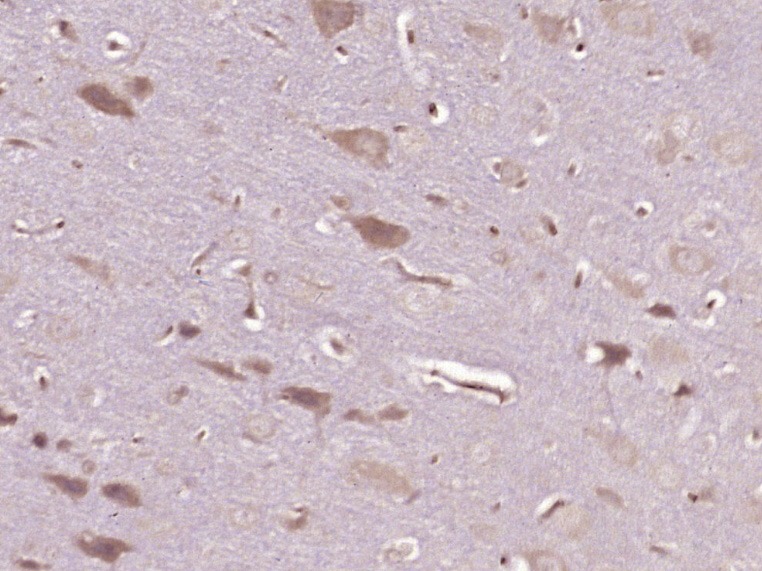购物车
全部删除  您的购物车当前为空
您的购物车当前为空
别名 OPRM1, Mu-type opioid receptor, Mu opioid receptor (MOP;hMOP), Mu opiate receptor, MOR-1, M-OR-1, MOR1
Anti-OPRM1 Polyclonal Antibody 是一种 Rabbit 抗体,靶向 OPRM1。Anti-OPRM1 Polyclonal Antibody 可用于 IF,IHC-Fr,IHC-P。
Anti-OPRM1 Polyclonal Antibody 是一种 Rabbit 抗体,靶向 OPRM1。Anti-OPRM1 Polyclonal Antibody 可用于 IF,IHC-Fr,IHC-P。
| 规格 | 价格 | 库存 | 数量 |
|---|---|---|---|
| 50 μL | ¥ 1,165 | 5日内发货 | |
| 100 μL | ¥ 1,975 | 5日内发货 | |
| 200 μL | ¥ 2,795 | 5日内发货 |
| 产品描述 | Anti-OPRM1 Polyclonal Antibody is a Rabbit antibody targeting OPRM1. Anti-OPRM1 Polyclonal Antibody can be used in IF,IHC-Fr,IHC-P. |
| 别名 | OPRM1, Mu-type opioid receptor, Mu opioid receptor (MOP;hMOP), Mu opiate receptor, MOR-1, M-OR-1, MOR1 |
| Ig Type | IgG |
| 反应种属 | Human,Mouse,Rat (predicted:Dog,Pig,Cow,Rabbit,GuineaPig) |
| 验证活性 | 1. Paraformaldehyde-fixed, paraffin embedded (Mouse brain); Antigen retrieval by boiling in sodium citrate buffer (pH6.0) for 15 min; Block endogenous peroxidase by 3% hydrogen peroxide for 20 min; Blocking buffer (normal goat serum) at 37°C for 30 min; Antibody incubation with (mu Opioid receptor) Polyclonal Antibody, Unconjugated (TMAB-01289) at 1:400 overnight at 4°C, followed by operating according to SP Kit (Rabbit) instructions and DAB staining. 2. Paraformaldehyde-fixed, paraffin embedded (Rat brain); Antigen retrieval by boiling in sodium citrate buffer (pH6.0) for 15 min; Block endogenous peroxidase by 3% hydrogen peroxide for 20 min; Blocking buffer (normal goat serum) at 37°C for 30 min; Antibody incubation with (mu Opioid receptor) Polyclonal Antibody, Unconjugated (TMAB-01289) at 1:400 overnight at 4°C, followed by operating according to SP Kit (Rabbit) instructions and DAB staining. 3. Paraformaldehyde-fixed, paraffin embedded (human cerebellum); Antigen retrieval by boiling in sodium citrate buffer (pH6.0) for 15 min; Block endogenous peroxidase by 3% hydrogen peroxide for 20 min; Blocking buffer (normal goat serum) at 37°C for 30 min; Incubation with (mu Opioid receptor) Polyclonal Antibody, Unconjugated (TMAB-01289) at 1:200 overnight at 4°C, followed by operating according to SP Kit (Rabbit) instructionsand DAB staining.    |
| 应用 | IFIHC-FrIHC-P |
| 推荐剂量 | IHC-P: 1:100-500; IHC-Fr: 1:100-500; IF: 1:100-500 |
| 抗体种类 | Polyclonal |
| 宿主来源 | Rabbit |
| 亚细胞定位 | Cell membrane; Multi-pass membrane protein. |
| 组织特异性 | Brain. Is expressed in the cerebral cortex, caudate putamen, nucleus accumbens, septal nuclei, thalamus, hippocampus, and habenula. Not detected in cerebellum. |
| 构建方式 | Polyclonal Antibody |
| 纯化方式 | Protein A purified |
| 性状 | Liquid |
| 缓冲液 | 0.01M TBS (pH7.4) with 1% BSA, 0.02% Proclin300 and 50% Glycerol. |
| 浓度 | 1 mg/mL |
| 研究背景 | This gene encodes one of three opioid receptors. The mu opioid receptor is the principal target of endogenous opioid peptides and opioid analgesic agents such a s beta-endorphn and enkephalins. The NM_001008503.1:c.118A>G allele had been associated with opioid and alcohol addiction and variations in pain sensitivity but evidence is conflicting. Multiple transcript variants encoding different isoforms have been found for this gene. [provided by RefSeq, Jun 2012] |
| 免疫原 | KLH conjugated synthetic peptide: human mu Opioid receptor |
| 抗原种属 | Human |
| 基因名称 | OPRM1 |
| 基因ID | |
| 蛋白名称 | Mu-type opioid receptor |
| Uniprot ID | |
| 研究领域 | Drugs and Chemicals,Opioid Receptors,Nociception |
| 功能 | Receptor for endogenous opioids such as beta-endorphin and endomorphin. Agonist binding to the receptor induces coupling to an inactive GDP-bound heterotrimeric G-protein complex and subsequent exchange of GDP for GTP in the G-protein alpha subunit leading to dissociation of the G-protein complex with the free GTP-bound G-protein alpha and the G-protein beta-gamma dimer activating downstream cellular effectors. The agonist- and cell type-specific activity is predominantly coupled to pertussis toxin-sensitive G(i) and G(o) G alpha proteins, GNAI1, GNAI2, GNAI3 and GNAO1 isoforms Alpha-1 and Alpha-2, and to a lesser extend to pertussis toxin-insensitive G alpha proteins GNAZ and GNA15. They mediate an array of downstream cellular responses, including inhibition of adenylate cyclase activity and both N-type and L-type calcium channels, activation of inward rectifying potassium channels, mitogen-activated protein kinase (MAPK), phospholipase C (PLC), phosphoinositide/protein kinase (PKC), phosphoinositide 3-kinase (PI3K) and regulation of NF-kappa-B. Also couples to adenylate cyclase stimulatory G alpha proteins. The selective temporal coupling to G-proteins and subsequent signaling can be regulated by RGSZ proteins, such as RGS9, RGS17 and RGS4. Phosphorylation by members of the GPRK subfamily of Ser/Thr protein kinases and association with beta-arrestins is involved in short-term receptor desensitization. Beta-arrestins associate with the GPRK-phosphorylated receptor and uncouple it from the G-protein thus terminating signal transduction. The phosphorylated receptor is internalized through endocytosis via clathrin-coated pits which involves beta-arrestins. The activation of the ERK pathway occurs either in a G-protein-dependent or a beta-arrestin-dependent manner and is regulated by agonist-specific receptor phosphorylation. Acts as a class A G-protein coupled receptor (GPCR) which dissociates from beta-arrestin at or near the plasma membrane and undergoes rapid recycling. Receptor down-regulation pathways are varying with the agonist and occur dependent or independent of G-protein coupling. Endogenous ligands induce rapid desensitization, endocytosis and recycling. Heterooligomerization with other GPCRs can modulate agonist binding, signaling and trafficking properties. Involved in neurogenesis. |
| 分子量 | Theoretical: 45 kDa. |
| 储存方式 | Store at -20°C or -80°C for 12 months. Avoid repeated freeze-thaw cycles. |
| 运输方式 | Shipping with blue ice. |
| 存储 | store at low temperature | store at -20°C |